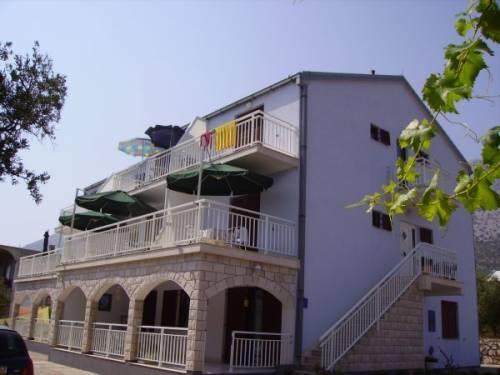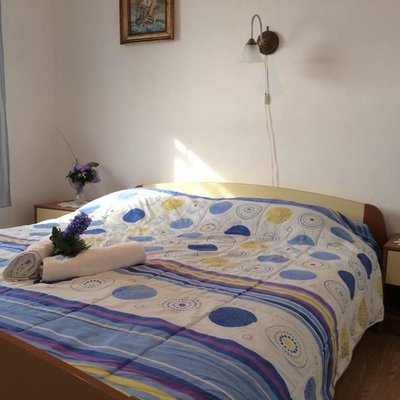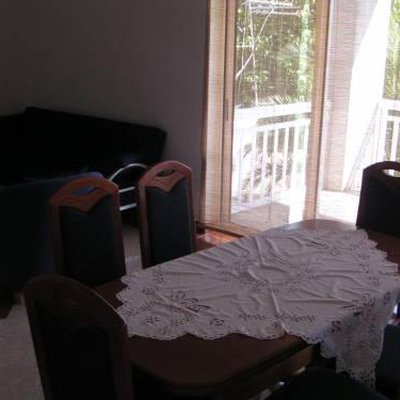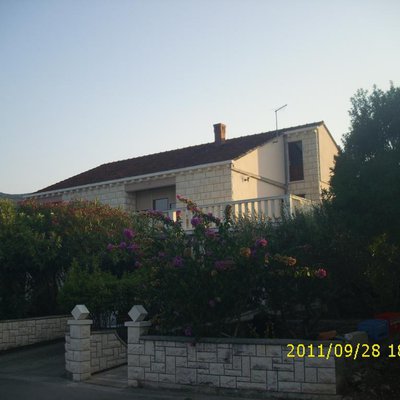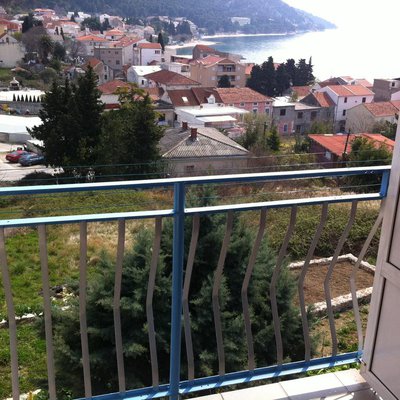Apartments and rooms, peninsula Peljesac
CROATIAN: The apartments are located in family house in a quiet part of the village are 350 m away from the sea and the main beach ... ENGLISH: Along with the Istrian peninsula, the Peljesac peninsula is one of the largest on the Adriatic coast. It stretches ... Polski: Orebic to znakomita propozycja aktywnego wypoczynku of Adriatykiem. The base umiejscowiona na po ³ wyspie Peljeœac ... DEUTCH: Ein Städtchen an der Südküste der Halbinsel Peljesac. Orebic war einst ein bedeutendes Seeverkehrszentrum ...
CROATIAN:
The apartments are located in family house in a quiet part of the village are 350 m away from the sea and main beach. In the yard are a grill, outdoor shower, and 4 bicycle parking to serve guests. The house is away from shops, restaurants, coffee bars, doctors, hospital pharmacies, super markets, fish market, markets, museums and places of the town from 200 to 800 m, and everything else is needed for a comfortable stay of tourists is located near that can be done without cars.
Konforni apartments are equipped with satellite TV, some terraces which overlook the sea and some mountain and some have and air conditioning. Orebic is a place rich in variety and number of beaches so that everyone can find what suits him and the place are very different sports-tennis courts, basketball, and football great and I offer a beautiful landscape areas of the lovers as mountain biking and road. Pleljesac peninsula is also known by indigenous superb wine known throughout the world (Dingac, Plavac Mali, Rukatac, Pošip, Procedure, ...) which together with the restaurant offering Peljesac makes an excellent place for people who love wine and good cuisine.
IRENA house guests we offer special discounts in the 5.6 and 9 and 10 months. We give discounts on the amount spent on the number of tourists.
Orebic is a small town located on the southwest coast of the Peljesac peninsula. It is a city on the sea, which divides the Peljesac channel from the island of Korcula, with which it is connected by ferry. Until it can be reached by sea and by land.
The earliest inhabitants of Peljesac peninsula, were the Illyrians, later came the Greeks, and Romans - what we witnessed archaeological finds. People of the region have always been, working the land, fought with the landslide of rocks that inflicting torrent with krševitoga mountain complex to the sea. Landslides have been stopped with stone barriers and thus shaped space between the fences and roads oldest settlements.
In the first half of the 14th century Dubrovnik from the Bosnian rulers bought the Peljesac Peninsula and the vlastela razdjelili it. Those in the 15 and 16th century built houses for the control of its properties, and thanks to the marine and quarry near Korcula in the 17th century houses are all the more solid wall and urednije.
In 1835th orebićku along the coast road which was built in the village obrubila, and through it the 1887th The water carried.At that time the coastal road, in the same intervals, were built four fountains like Attica profiled with the central semi-circular gable end and the bottom shell.
Urban identity consists precisely of those homes that were created along the northern coastal road. Those with their fronts and gardens are a picturesque park zone. The back of the house is mainly a space for economic and agricultural affairs, and for the cultivation of fruits and vegetables and away the stalls for animals. Everything is fenced wall, and out of the hill provides the field with olive trees, vineyards and groves. The garden in front of the house is gradually formed mainly by gotičkorenesansnom same pattern: a long passageway called the court KORTA approached the broad courtyard in front of the house called. prikuće.
Orebic today operates mainly as a tourist destination, with no industry and few are still sailors and farmers. Many of the old captain houses were renovated in the last decades for tourist purposes.
ENGLISH:
Along with the Istrian peninsula, the Peljesac peninsula is one of the largest on the Adriatic coast.It stretches from the Isthmus of Stone all the way to Cape hunting ground in the northwest and it is 65 kilometers long. Some of its larger towns are Ston, Brijesta, Trpanj, Viganj, and Orebic. The Peljesac peninsula's mountains are known hunting grounds for mouflons. Its inhabitants mostly make their living off of tourism, wine-growing manufacturing-Dingac wine in the wine cellars of Potomje and Stone, as well as fishing and stockbreeding. It is also known for its salt-works and cultivating seashells. Peljesac is a charming place thanks to its many historical churches, exquisite royal villas as well as its delicious first class wines.
Stretching along the Isthmus, which connects Peljesac to the mainland, are fortress walls which were built by the Republic and served to prevent access to the peninsula. These walls were built by the same architects and contractors who raised Dubrovnik's fortress walls: Michelozzo Miichelozzi, George Dalmatian and Onofrio Della Cava.Orebic is a small city and the most well-known located on the southern coastline of the Peljesac peninsula, opposite to the island of Korcula. Its most popular beach is Trstenica. Orebic is surrounded by beautiful Mediterranean vegetation: pine trees, almond trees and citrus trees.Here accommodations include everything from hotels, apartments and villas to more natural settings offered by its many Campsites. Orebic was once an important nautical destination and it was named after a captain's family, Orebic, in the 16th century.
Trpanj is a harbor town and located on the northern coast of Peljesac and at the foot of the summits, and Ostro Vitara. Trpanj developed near villa rustica and up on the summit lie the ruins of a medieval fortress. This wonderful town offers beautiful pebbled beaches, Untouched nature and it is the perfect place to enjoy a relaxing holiday with the family.
Viganj is a small town with lovely pebbled beaches and beautiful pine forests. Just north-east of Viganj is the mountain resort of St. Elias where visitors can enjoy hiking and longs walks through nature.
Ston is known for its salt-works and oyster farming. The town's coastline, which stretches down the canal and into the inlet Papratna, is a wonderful place where visitors can enjoy swimming, fishing and scuba diving. Ston is surrounded by a 980m long wall with fortifications. Ston's largest fortress is great Kastio whose wall stretches along the town's coastline and, looking out towards the sea, borders with the salt-works.This large complex was built by the people of Dubrovnik (from the year 1330-1506). The people of Stone are also known for their wine making expertise and guests can verify them by visiting the town's many wine cellars and Taverns.
Mali Ston (Little Ston) is located in a small inlet. It is known for the cultivation of seashells within the Bristina inlet and the Mali Ston canal. The town is surrounded by fortress walls in the shape of a square and facing the harbor is the main entrance to the town. All of its streets were built at a right angle. On an elevation in the southern part of town, in the year 1347, the building of a Stronghold, including five towers, began and later named Koruna. The Great Wall stretches from this Stronghold to the town of Ston. The port of Mali Ston was completed in the year 1490th It was built to resemble the harbor of Dubrovnik and embedded in it are three arsenals which were used to store small warships.
Guests can also take the time to visit some of the many smaller towns on the Peljesac peninsula such as Duba, Crkvice, Trstenik, Zuljana, Drace, Janjina, Kuna, Oskorušno, Upper Vrucica, Potomje and Procedure
House contains 12 apartments for or 2 +1.2 +2.3 +1.3 +2, 5 +2, 6 +2, person, equipped vith furniture, some apartments have air conditioning, and every apartment has a total equipped kitchen. Each apartment has sleepping room with double bed, bathroom, kitchen and dinning room and a terace with a seawiev.
House with apartments and rooms "IRENA" is in the famoust Orebic is a tourist destination, it is known as a maritime center of the southern Dalmatian peninsula Peljesac, famous for wines and wine growing. It lies on the southern coast of the peninsula that is connected to the mainland by road via Ston and by ferry line Ploce - Trpanj. The whole peninsula, covered with dense evergreen and Mediterranean vegetation, belongs to the warmest places on the Adriatic thanks to the many sunny days. In Orebic, there is a wide range of tourist services: private and hotel accommodation, sporting and recreational facilities (including tennis courts and football fields), water sports (all necessary equipment can be rented on the beaches), and sailing and windsurfing courses. The surroundings are ideal for walks, hiking and gathering of plants, while the wine slopes in the interior are dotted with wine trails and wine cellars where you can taste or buy homemade Peljesac wine and "average "- a sweet liquor made from grapes. There is a large sandy beach in the bay of Trstenica, while there are numerous rocky bays with small beaches close to Orebic for those looking for privacy. Orebic is proud of its gastronomic specialties, primarily oysters and mussels bred in the area, as well as its wines Dingac and Procedure. Peljesac is the name of the huge peninsula, which is 65 km long (from Ston in the east to the hunting ground in the west). The highest peka is Saint Elias above Orebic, it is 961 m high. The inhabitants have always occupied themselves mainly with wine-growing and shipping. For the island of Korcula, Peljesac is land and the early settling of Korcula took place from Peljesac.
OREBIC (Orebic), a small town on the southern coast of the Peljesac Peninsula, population 1.489. An average air temperature in January is 9.1 ° C and in July 26.5 ° C. The surroundings is characterized by luxuriant Mediterranean vegetation. Economy is based on farming, fruit growing, fishing and tourism. Among the beaches, the most interesting is the cove of Trstenica. Orebic has ferry lines with Korcula Orebic has ferry lines with Korcula. It is located on the regional road running along the peninsula.In the past Orebic was an important maritime center, until the 16th century it was called Trstenica and was the duke's seat under the administration Dubrovnik (1343-1806). - Stone tumuli and fortifications (on the hills of Gruda and Vizanjica) date back to the prehistoric times. The traces of a Roman habitation (remains of a Roman villa - villa rustica, graves) have been found as well. The small Baroque church has an early Christian marble relief built-in above the door of the closed arcade. Orebic has also the Maritime Museum. The Gothic-Renaissance Franciscan monastery (15th c.) is located 2 km west of Orebic; it features a collection of works of art. The monastery church was built in 1486 by Mihoci Radisic, the main portal features the relief of the Madonna, a work by an anonymous Disciple of N. Fiamberti; in the church is another relief of Madonna, made by Florence Nicholas (Nicholas of Florence). - On the hill above the monastery is a Gothic church, restored in Baroque style, dedicated to Our Lady of Karmen. Next to it are ancient sarcophagi and several age-old, huge cypresses, as well as a Baroque loggia and the ruins of the Trstenica duke's castle.Since ancient times Orebic has developed as a mari-time center (the town was named after a family that gave several captains). The Peljesac Shipping Society was founded in 1865 and had as many as 33 ocean clippers (sailing ships). As one of the largest shipping societies on the Mediterranean, it also opened its own shipyard. When steamers replaced sailing ships, the Society and Orebic suffered very bad times. However, navigation remained the most appreciated and occupation in Orebic on the Peljesac Peninsula.
Today, Orebic is an important tourist resort, offering various accommodation facilities (hotels, apartments), long sand beaches, numerous small coves and clear seawater, as well as sports and recreational facilities and opportunities (tennis courts, football, yachting, windsurfing) outstanding gastronomic offer - especially seafood and famous Peljesac wines (Dingac, Procedure) - and pleasant walks in the surroundings. The cemetery near the church of Our Lady of Karmen above Orebic, the final resting-place of Peljesac born captains, offers a beautiful view on the island and the town of Korcula, as well as on numerous islets in the Pelje-sac Channel. Below the Franciscan monastery and the church is a forest of cypress, protected as a forest park.The ships passing through the Peljesac Channel sound their sirens to greet the church of their patron saint and the resting place of deceased captains, and are replied by sounding of the monastery bells.
Close to the monastery is the village of Karmen with several Mediaeval monuments. It is the starting point of walking tours to the picturesque villages of Upper RUSKOVIĆ, Stankovic and Podvlaštice. One of the favorite Ascents to the peak of Sveti-Ilija (St. Elias) (961 m) also starts here.
Numerous traditional religious feasts take place in Orebic and the surroundings, the most notable being the feast day of Our Lady of Karmen (16th of July). Theater tours are organized in the summer months, as well as other cultural events and entertainment program.
Polski:
Orebic to znakomita propozycja aktywnego wypoczynku of Adriatykiem. The base umiejscowiona na po ³ wyspie Peljeœac ok. 90 km na po ³ night of "Per ³ y Adriatyk - Dubrovnik. Hotelowe Complex - apartamntowy wraz z kampingiem by ³ o ¿ony jest nad samym brzegiem morza w otoczeniu grove oliwkowego and sosnowego. Naprzeciw pla ¿y, oddalona on ok. 1.5 kilometers wyspa Korćula z zabytkowym miasta o tej samej nazwie.
Dwa równoległe ³ e pasma wysokich gór na po ³ wyspie and wyspie and oddzielaj ¹ cy the dog wody tworz ¹ ³ henna, Gdzie letni wiatr mistral przyspieszaj ¹ c tworzy wymarzone miejsce do uprawiania windsurfing (uznawane for najlepsze w Chorwacji). Is to równie ¿doskona ³ e miejsce do przeprowadzenia wypraw kajakowych s siaduj ¹ ¹ ce ma ³ e wysepki a WOD ¹ dla znudzonych to wypraw rowerowych (wypo ¿yczalnia rowerów) lub beztroskiego powêdrowania by górach (of baz ¹ góruje szczyt Œw.Lliji -961 mnpm) OUR ¿¿y tak e nadmienić and podwodny œwiat ¿z ³ per udniow it ¹ ¿¹ faun and Flor ¹ oraz kryszta ³ ow ¹, ciep WOD ³ ¹ ¹ ¹ niezapomniane warunki stwarzaj to nurkowania.
Uczestnicy chc ¹ cy skosztować tak ¿e kulturalnych rozrywek, mog ¹ przeprawić się do miasta changing Houston (turystyczny prom dogs ¿erski kursuje co godzina). Miasto z is known to festiwali tañca ludowego, które odbywaj ¹ się przez okres cyklicznie letni.Chc ¹ cych zwiedzić Najpiękniejsze miasta Chorwacji Zapraszamy natomiast to do with WYCIECZKA fakultatywne ³ awnego Dubrovnik, Medjugorje, Split and Trogir, Krka rzeka wodospady of the lub ca ³ ¹ odzienn WYCIECZKA statkiem to Narodowego Wyspy Park Mljet by czonego ¹ z ¹ k pielami and obiadem (tzw. "Fish Piknick) .-
Orebic - P ³ w. Peljeœcać rozci it ¹ się przez 65 km miêdzy sta ³ ym l ¹ dem a wyspami ¹ Korcula and Mljet. This co przede wszystkim ujmuje turystê przyj ¿d ¿aj ¹ tutaj cego by raz pierwszy is niezwyk ³ y landscape. Wje ¿d ¿aj ¹ c na p ³ w. of strony l ¹ du samego of pocz ¹ tku widzimy wzgórza, a potem coraz wiêksze góry poroœniête lush roœlinnoœci ¹ ¹ lasów œródziemnomorskich. By ³ udniowe cattle wzgórz to przede wszystkim uprawy winnej latoroœli, bo to w ³ aœnie at P ³ w. Peljeœcać with one produkowane ¹ z najlepszych gatunków win chorwackich. It równie ¿dowód du ¿e to us ³ onecznienie field, and wiêc GWARANCJI pogody, d ³ ugi season ciep ³ e
DEUTCH:
Ein Städtchen an der Südküste der Halbinsel Peljesac.Orebic war einst ein bedeutendes Seeverkehrszentrum. Entdeckt wurden Spuren einer Römersiedlung. Im Ortskern kann man das Seefahrtsmuseum besichtigen.
Heute ist ein Orebic bedeutender Fremdenverkehrsort, neben der Langen Sandstränden, Buchten vielen kleinen und dem sauberen Meer vielfältige Unterkunftsmöglichkeiten zu bieten hat und außerdem mit einem reichhaltigen Sport-und Freizeitangebot (Tennis, Fußball, Segeln und Surfing) aufwarten kann. Natürlich Nicht zu vergessen die Gastronomie mit Fischen, Meeresfrüchten und Weinen von den bekannten Peljesac (Dingac, Procedure). Die Umgebung bietet sich an für angenehme Spaziergänge. Vom Friedhof der neben der Kirche von oberhalb Engelsmadonna Orebic, hat man einen Blick auf Korcula herrlichen und den gleichnamigen Hauptort sowie auf der Insel die zahlreichen Inselchen im Channel von Peljesac. Unter dem Franziskanerkloster und der Kirche breitet sich ein Zypressenhain aus, der als Parklandschaft steht unter Naturschutz.
Unweit des Klosters liegt der Ort mit mehreren Karmen mittelalterlichen Baudenkmälern. Von dort aus kann man zu den Ausflüge im Hochland gelegenen malerischen Ortschaften RUSKOVIĆ, Stankovic Podvlaštice und machen.Orebic ist auch der der Ausgangspunkt beliebten Wandertour auf den St. Elijah (961 m).
